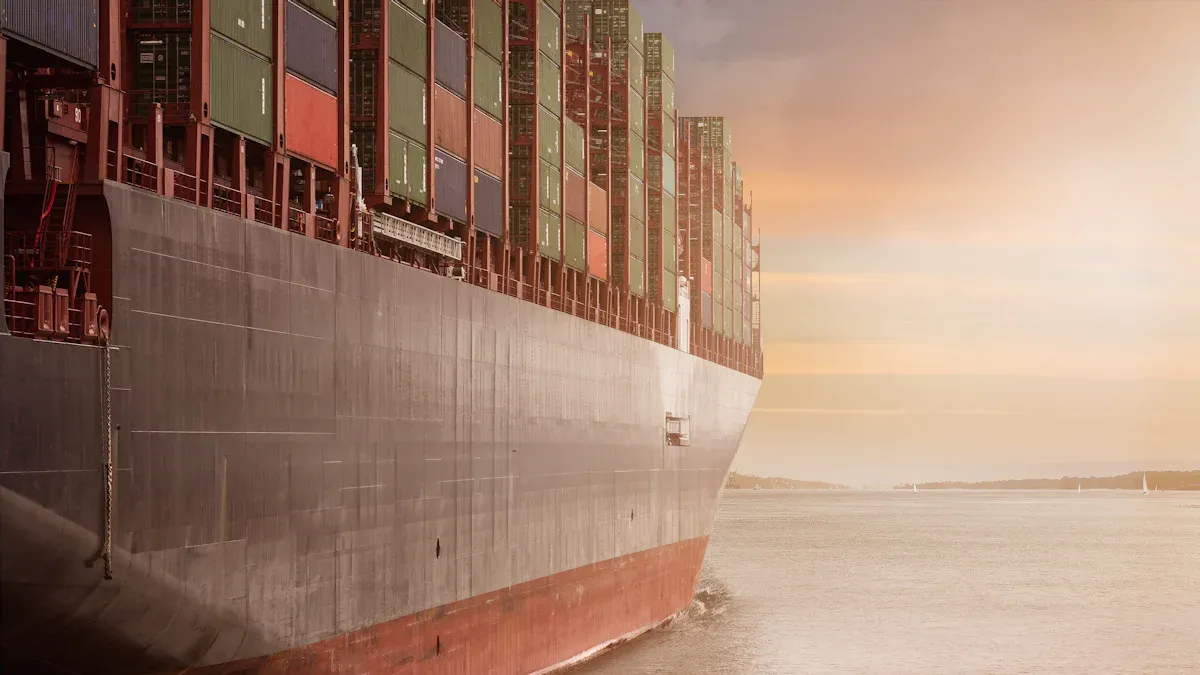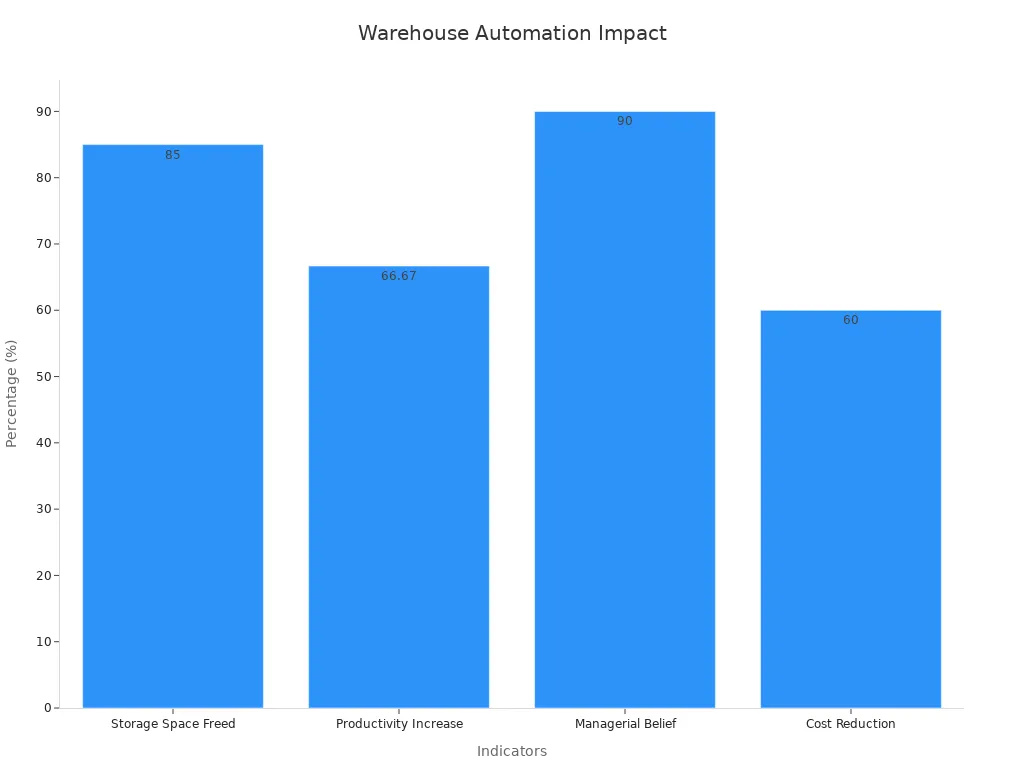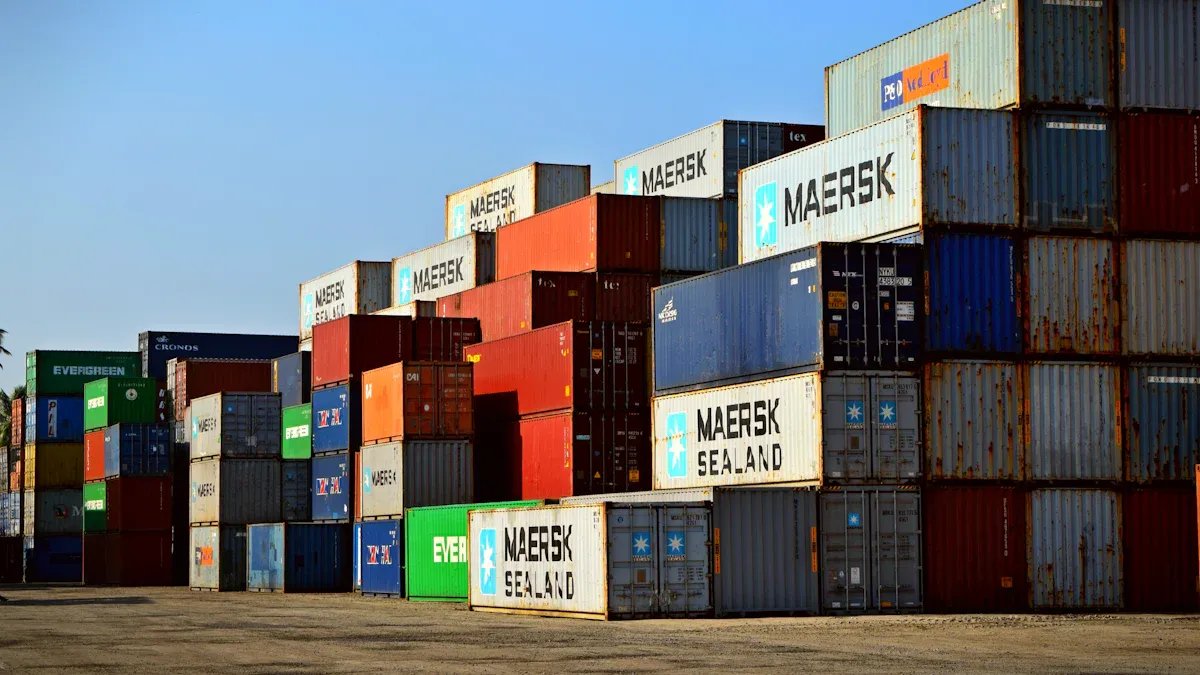How AI is Optimizing International Freight and Supply Chains

Artificial intelligence is transforming international logistics by making it faster. It helps lower costs, improve services, and manage stock better. Companies using AI have cut shipping costs by 15%. They also reduced their stock levels by 35%. Service quality has gone up by 65%, demonstrating AI's significant impact. Spending on smart tech for industries may grow substantially, potentially rising from $1.67 billion in 2018 to $17.41 billion by 2025. AI's role in international logistics is expanding rapidly.
Key Takeaways
AI lowers shipping costs by 15%, helping businesses save money.
Using AI makes services 65% better, keeping customers happy and loyal.
AI tools guess demand well, cutting errors by 50% and stopping extra stock.
Real-time AI tracking updates customers, reducing calls by 65% and building trust.
AI automation in warehouses improves work by 66.67%, letting workers do key tasks.
The Role of AI in International Logistics

Understanding AI's Impact on Global Supply Chains
AI is changing global supply chains by making them better. It automates tasks and improves workflows, saving time and money. AI studies large data to give useful advice. This helps you make smart choices instead of guessing. It also predicts demand and plans routes to avoid problems. Companies using AI have cut logistics costs by 15%. They improved stock levels by 35% and service quality by 65%. These changes show how AI is improving transport and global logistics.
Key Technologies Driving AI in Logistics
AI tools are changing how logistics work. Demand forecasting predicts trends to manage stock better. Route planning lowers delivery miles and costs, saving money. Smart warehouses use AI to organize storage and speed up work. Real-time tracking gives instant updates on shipments, boosting efficiency. Together, these tools create a smooth logistics system. They help businesses adjust quickly to new needs.
AI Application | How It Helps Logistics |
|---|---|
Demand Forecasting | Makes demand predictions more accurate |
Route Optimization | Cuts delivery miles and saves money |
Intelligent Warehousing | Speeds up storage and logistics processes |
Real-time Monitoring | Gives fast updates to improve operations |
JUSDA's Approach to AI-Driven Logistics Solutions
JUSDA uses advanced tech to offer AI-based logistics solutions. Its JusLink platform combines AI, IoT, cloud, and big data. This improves supply chain tracking and teamwork. JusLink has tools like sales forecasting, smart restocking, and risk management. These tools help manage stock, cut risks, and move goods efficiently. JUSDA’s platform also organizes demand forecasts, delivery plans, and customs work. Using these tools makes global logistics easier and faster.
Key Applications of AI in Freight and Supply Chains
Predictive Analytics for Demand Forecasting
AI helps predict demand by studying past data and trends. It looks at things like seasons, market changes, and customer habits. This reduces mistakes by 50% compared to old methods. Better predictions stop overstocking or running out of items. This keeps customers happy and loyal.
Big companies like Amazon and Walmart use AI for planning. Amazon uses it to manage stock and prices. Walmart uses it to improve inventory tracking. Other brands like PepsiCo and Unilever have seen big improvements. Their forecast accuracy went up by 10% to 75%.
Company | Use of AI | Result |
|---|---|---|
PepsiCo | Demand forecasting | 10% better forecast accuracy |
Unilever | AI analytics | 75% more precise predictions |
Coca-Cola | AI forecasts | 10-20% less extra stock needed |
Amazon | Stock and price planning | Better efficiency and happier customers |
Walmart | Warehouse automation | Faster orders and fewer mistakes |
Route Optimization for Efficient Deliveries
AI makes deliveries faster by planning better routes. It uses traffic, weather, and past data to avoid delays. This saves fuel, cuts delivery times, and lowers pollution. Bad routes can raise delivery costs by 30%. In the U.S., traffic jams cost $87 billion in lost time each year.
AI tools help solve these problems. They save money and make deliveries quicker. Companies like Amazon and Walmart use AI to deliver on time. This keeps customers satisfied and loyal.
Benefit | How It Helps |
|---|---|
Lower Fuel Costs | Smart routes use less fuel, saving money for delivery trucks. |
Quicker Deliveries | AI avoids traffic, so packages arrive faster. |
Less Pollution | Better routes mean less driving and cleaner air. |
Happy Customers | Fast deliveries make customers trust and like the service. |
Warehouse Automation and Robotics
AI-powered robots make warehouses work better and cheaper. Robots do tasks like sorting, packing, and checking stock. This frees up 85% of storage space and boosts worker output by 66.67%. Most managers, about 90%, agree that automation improves efficiency.
Walmart is a leader in using warehouse robots. They use them to manage stock and speed up order processing. This saves money and ensures accurate work. The benefits of automation are clear in these numbers:
Indicator | Value | What It Means |
|---|---|---|
Space Saved | 85% | More room for stock without needing bigger warehouses. |
Productivity Boost | 66.67% | Workers get more done with robots handling boring tasks. |
Manager Support | 90% | Most managers think automation makes warehouses better. |
Cost Savings | 60% | Many businesses spend less on warehouse operations after using robots. |

Real-Time Tracking and Visibility with JusLink
JusLink changes supply chain management with real-time updates. It uses AI, IoT, and big data to track shipments. You can see where your goods are at all times. From the warehouse to delivery, you stay informed. This helps you fix problems quickly and avoid delays.
Real-time tracking makes deliveries faster and more efficient. If bad weather or traffic happens, JusLink sends alerts. You can change routes to save time and money. This keeps costs low and customers happy. Companies using JusLink report quicker deliveries and better service.
JusLink works well with other systems like ERP and WMS. This makes managing supply chains easier. Using JusLink gives businesses an advantage with smarter decisions and better teamwork.
Risk Management and Disruption Mitigation
AI helps stop problems in supply chains before they grow. It studies lots of data to find risks like delays or market changes. This lets you act fast and avoid bigger issues. For example, AI can spot trends and help adjust stock levels to meet demand.
AI also improves tracking and reduces fraud with blockchain. It follows rules and finds problems early. AI tools collect data and detect unusual events in real time. This helps you fix risks quickly.
Studies show AI is great for managing risks. Experts like Ivanov D. and Gupta S. lead this research. Schools like Hong Kong Polytechnic University are advancing AI in supply chains.
Category | Insights |
|---|---|
Authors | Experts like Ivanov D. and Gupta S. study risk management. |
Countries | China, the U.S., and Germany lead in AI supply chain research. |
Documents | Works by Baryannis G. and Ivanov D. are important in this field. |
Organizations | Hong Kong Polytechnic University leads in AI supply chain research. |
AI helps businesses use strategies like dual sourcing. This means relying on more than one supplier. It lowers risks and keeps goods moving during problems. AI helps create strong and steady supply chains.
Benefits of AI in International Logistics
Cost Savings and Operational Efficiency
AI helps cut costs and make supply chains better. It finds the best routes, saving 10% to 20% on fuel. Faster deliveries and better planning boost productivity. Smart routes also lower repair costs for vehicles. More deliveries can be done without needing extra trucks.
Benefit | Description |
|---|---|
AI finds better routes, saving 10% to 20% on fuel. | |
Improved Efficiency | Faster deliveries and better productivity with smarter planning. |
Reduced Operational Costs | Less vehicle wear and tear means lower repair expenses. |
Increased Delivery Capacity | Handle more deliveries without needing extra trucks or drivers. |
Enhanced Customer Satisfaction | On-time deliveries make customers happy and loyal. |
Companies using AI save a lot of money. About 82% of them report lower costs. AI also cuts problems by 20% to 40%, making work smoother. These changes show how AI is improving global logistics.
Enhanced Decision-Making with Data-Driven Insights
AI helps make smarter choices by studying lots of data. It tracks delivery times, fuel use, and stock levels. For example, it checks on-time deliveries and stockouts to improve supply chains.
Metric Type | Specific Metrics | Purpose |
|---|---|---|
Operational Metrics | On-Time Delivery, Delivery Time Variance, Dwell Time | Make deliveries faster and more reliable. |
Transportation Efficiency | Miles per Gallon, Empty Miles Ratio, Load Factor | Save fuel and plan better routes. |
Inventory Management | Inventory Turnover, Stockout Rate | Keep shelves stocked and customers happy. |
Labor Productivity | Pick and Pack Accuracy, Labor Hours per Shipment | Use workers’ time better and reduce mistakes. |
AI uses data to predict demand, plan routes, and manage stock. This stops waste and uses resources wisely. With AI, businesses can stay ahead in the logistics world.
Improved Customer Experience Through Real-Time Updates
Real-time updates make customers happier. AI tools like JusLink show where shipments are at all times. This keeps customers informed and builds trust.
Some companies, like C&S Wholesale Grocers, have seen big improvements. Real-time tracking cut customer service calls by 65% in four months. Customers like getting updates, which makes them more loyal.
AI also helps fix problems fast. If bad weather or traffic happens, alerts let you change routes. This keeps deliveries on time and improves customer satisfaction.
Sustainability and Resource Optimization
AI is changing logistics to save resources and help the planet. It cuts waste, lowers pollution, and uses energy better. For example, AI checks how much energy is used and finds ways to save it. This saves money and reduces harm to nature. Many companies now use less energy thanks to AI.
AI also helps control pollution and manage waste. Smart systems find problems and fix them fast. They track pollution levels in real time to follow rules. AI improves things like cleaning wastewater, making businesses more eco-friendly.
AI makes supply chains better by predicting demand correctly. This stops overproduction and wasting extra stock. Fewer resources are wasted, and businesses can meet real customer needs. AI-powered smart grids also save energy, making logistics greener.
AI does more than just help logistics. It protects nature and tracks climate changes. For example, AI finds areas at risk of deforestation or pollution. This helps people act early to save natural resources.
Using AI in logistics makes work greener and more efficient. It lowers carbon footprints while keeping productivity high. Automation ensures resources are used wisely, helping both businesses and the environment.
Challenges in Using AI for Logistics
Keeping Data Safe and Private
AI in logistics uses a lot of data. Protecting this data is very important. Customer details and shipment records must stay secure. Using personal data without permission raises ethical issues. Companies must follow rules like GDPR and CCPA to protect privacy.
One way to keep data safe is by removing personal details. This process, called anonymizing, lowers the risk of misuse. Strong cybersecurity tools like encryption and firewalls are also needed. These tools stop cyberattacks and protect systems. Studies show 97% of security teams use AI tools. About 85% of them spent more on AI last year. These tools help find threats and make security work easier.
Connecting AI with Old Systems
Adding AI to old logistics systems can be hard. Older systems may not work well with new AI tools. This makes it tough to access and use data. Old hardware may also lack the power AI needs to run.
Other problems include resistance to change and lack of skills. Limited budgets can also slow down AI adoption. To fix this, companies can use small steps to add AI. Middleware can help old systems connect with AI platforms. Training workers and using cloud computing can also make the switch easier.
Training Workers for AI
Using AI in logistics needs skilled workers. Many employees don’t know how to work with AI systems. Training programs are important to teach them new skills. These programs show workers how to work with AI, not against it.
Skills like problem-solving and flexibility are very important. Companies that invest in training create programs focused on AI. This helps workers learn and stay useful in their jobs. As AI grows in logistics, trained workers will be key to success.
High Initial Costs and ROI Challenges
Using AI in logistics needs a lot of money upfront. You must spend on new tech, skilled workers, and system updates. These costs can feel too high, especially for small businesses. But knowing the return on investment (ROI) helps you decide wisely.
It’s hard to predict how much AI will help. Many companies don’t plan for uncertainties, making ROI seem better than it is. For example, checking ROI soon after starting AI might miss future problems. Also, looking at one project at a time ignores how projects work together.
Key Points | Explanation |
|---|---|
Uncertain Benefits | Companies often miss risks when expecting AI results. |
Short-Term ROI Focus | Early ROI checks may not show long-term issues. |
Ignoring Project Links | Looking at projects alone misses their combined effects. |
AI has big benefits like fewer mistakes, smarter choices, and happier customers. These can save money and grow profits. But to get these results, you need good planning and regular checks.
Benefit | How It Helps |
|---|---|
Fewer Mistakes | AI reduces errors, saving money and improving accuracy. |
Smarter Decisions | AI gives data insights for better choices. |
Better Customer Service | AI creates personalized experiences that boost sales and loyalty. |
To get the most from AI, think long-term. Look at how AI helps your whole business, not just one part. Check progress often and change plans as needed. By solving these issues, AI can become a strong tool for your logistics.
The Future of AI in International Freight and Supply Chains

New Trends in AI-Driven Logistics
AI is changing logistics with smart tools and systems. AI-powered order checks catch mistakes early. This stops problems before they happen. Predictive tools help guess demand more accurately. This cuts waste and improves stock management.
Automation is speeding up contract work too. For example, AI processes shipping contracts 75% faster than people. It learns from past fixes to do better next time. These tools make supply chains faster and more reliable.
AI also plans better routes, cutting pollution by 15%. Smart energy systems in warehouses save 10-20% on energy use. These changes make logistics efficient and eco-friendly.
Self-Driving Freight Systems and Their Benefits
Self-driving trucks will change how goods are moved. They can cut costs by 42% per mile on long trips, says McKinsey. This makes them a cheaper way to handle growing freight needs.
The trucking industry is also finding ways to save energy and cut pollution. These systems help electric trucks work better, making logistics greener. With U.S. freight expected to reach 21 billion tons by 2030, self-driving trucks will be key to meeting demand.
Study/Source | Key Insight |
|---|---|
McKinsey | Self-driving trucks cut costs by 42% per mile on long trips. |
Trucking Industry Research | New tech saves energy and supports electric trucks. |
American Trucking Associations | Freight will hit 21 billion tons by 2030, needing automation. |
AI's Role in Stronger Supply Chains
AI helps supply chains handle problems better. It predicts risks and improves stock management. This shortens wait times and helps deal with surprises quickly.
AI also makes decisions smarter by organizing data in one place. This reduces mistakes and improves teamwork. Studies show AI boosts supply chain performance, making it a must-have tool for success.
Key Findings | Description |
|---|---|
AI's Impact on Supply Chains | AI improves supply chain performance quickly. |
Better Data Use | Organized data helps with decisions and problem-solving. |
Research Details | Data from 279 companies proves AI helps supply chains. |
Using AI builds supply chains that adjust to problems and stay efficient. This keeps businesses competitive in a fast-changing world.
Long-Term Benefits for Global Trade and Commerce
AI is changing global trade by offering lasting benefits. It makes supply chains work faster and more reliably. AI predicts what customers need, helping avoid making too much or wasting resources. This saves money and uses materials wisely.
Did you know? AI-powered supply chains can help economies grow. When businesses work better, they strengthen economies and create new trade chances.
AI also helps stop problems before they grow. It spots delays or market changes early and offers fixes. This keeps goods moving smoothly, even during tough times.
AI boosts economic growth by solving low productivity issues. It helps businesses make more with fewer resources. This creates new markets and expands trade, giving businesses more ways to grow worldwide.
Key Long-Term Benefits of AI in Trade:
Faster and better production and shipping.
Early problem-solving for smoother operations.
Higher productivity that grows economies.
New markets and trade opportunities.
AI’s effects go beyond single businesses. It makes global supply chains stronger and more flexible. Using AI helps you succeed in a world where speed and innovation matter most.

JUSDA Solutions
To provide you with professional solutions and quotations.
AI is changing global shipping by lowering costs and improving services. It helps predict needs better, reducing mistakes by half. AI also automates tasks, saving 10% to 15% in expenses. To use AI fully, fixing issues like data safety and system updates is important.
In the future, AI will improve supply chains with smart tools. It will predict repairs and plan better routes. These changes will save fuel, cut delays, and make systems stronger. Using AI keeps businesses ready for changes in the logistics world.
See Also
Transforming Logistics: The Future of AI Supply Chains
Enhancing Productivity: Innovations in AI-Driven Supply Chains
Exploring AI's Hidden Capabilities in Modern Logistics
Innovative Supply Chains: Redefining the Logistics Landscape
